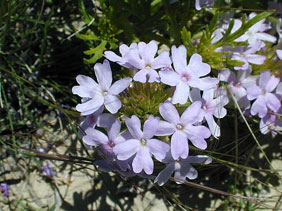DAKOTA VERBENA
|
 |
| File Size: 81 KB |
|
|
|
Glandularia bipinnatifida (Nutt. ) Nutt.
|
| [=Verbena bipinnatifida Nutt.] |
| Smoky Valley Ranch, Logan County, Kansas |
| Perennial |
| Height: 6-18 inches |
| Family: Verbenaceae - Vervain Family |
| Flowering Period: May, June, July |
|
| Also Called: | | Prairie verbena. | | Stems: | | Prostrate, decumbent or ascending, several to many, stout, to 24 inches long, much-branched from bases, moderately to densely hairy. | | Leaves: | | Variable, opposite, simple, stalked, 1-3-pinnately divided into linear or linear-oblong segments, .5 to 2.5 inches long, .5 to 2.5 inches wide, stiff-hairy; margins often rolling downward; tips blunt to slightly pointed. | | Inflorescences: | | Spikes, thick, 1/2 to 8 inches long, umbrella-like, terminal. | | Flowers: | | 5-parted; calyx lobes unequal, veins hairy; corollas 1/4 to 1/2 inch wide, lavender, pink, or bluish purple, outer surface hairy; lobes 5, spreading; tips notched; stamens 4, in 2 groups. | | Fruits: | | 4 nutlets, cylindric, pitted, grayish black, each 1-seeded. | | Habitat: | | Dry prairies, plains, pastures, disturbed areas, and roadsides, most abundant on rocky slopes. | | Distribution: | | Throughout Kansas. | | Uses: | | Native Americans sometimes used the leaves in treatments of snakebites. | | Comments: | | Though hardy and drought resistant, Dakota verbena does not compete well with other plants. |
|
| Dakota verbena inflorescences |  | | 168 KB | | Smoky Valley Ranch, Logan County, Kansas |
| | Dakota verbena |  | | 147 KB | | Konza Prairie, Riley County, Kansas |
| | Dakota verbena flowers and leaves |  | | 139 KB | | Konza Prairie, Riley County, Kansas |
| | Dakota verbena |  | | 98 KB | | Konza Prairie, Riley County, Kansas |
| | Dakota verbena |  | | 161 KB | | Mitchell County, Kansas |
| | Dakota verbena |  | | 79 KB | | Russell County, Kansas |
| | Dakota verbena |  | | 113 KB | | Russell County, Kansas |
| | Dakota verbena habit |  | | 211 KB | | Russell County, Kansas |
| | Dakota verbena habit |  | | 187 KB | | Gove County, Kansas |
| | Dakota verbena leaves |  | | 145 KB | | Konza Prairie, Riley County, Kansas |
|
|
|
|
|
|
|